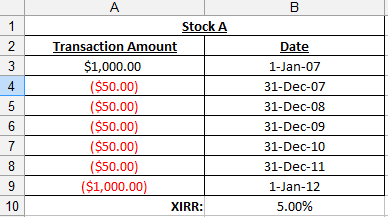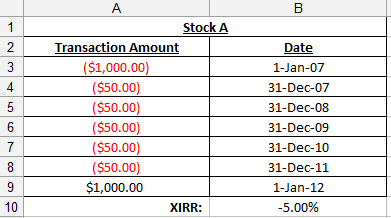 [/caption]
Maintaining my stock portfolio has always been a challenge for me. I use a simple method of calculating my current stock value plus dividends against my original investment amount. However, I have a nudging feel that this is flawed because I did not account for the various transactions throughout the life of holding on to the stock e.g. subscribing to rights or selling part of it. I have tried using CAGR but it still does not address the above problem. It is only until recently when I read about XIRR in Bro8888 article that I may have found the answer.
I'm going to use the steps as described in this article but instead of calculating base on my entire portfolio, I will try it out on just one stock first. Luckily I still have entire statement records from SGX detailing my transactions.
My major headache is how to classify dividends. If you do not reinvest your dividends back into your stock, it is considered as an outflow (negative) but if the dividends are parked as cash as part of your entire portfolio, it can be considered as inflow. However what if the stock price doesn't move but provide you with a constant yield of 5% p.a., won't my XIRR be negative?
I decided to do a hypothetical test. Assuming I buy one lot of Stock A at $1 a share in Jan 2007 and received a 5% dividend each year. The price at 1 Jan 2012 remains at $1.
[caption id="attachment_27421" align="aligncenter" width="391" caption="I am losing money??"]
[/caption]
Maintaining my stock portfolio has always been a challenge for me. I use a simple method of calculating my current stock value plus dividends against my original investment amount. However, I have a nudging feel that this is flawed because I did not account for the various transactions throughout the life of holding on to the stock e.g. subscribing to rights or selling part of it. I have tried using CAGR but it still does not address the above problem. It is only until recently when I read about XIRR in Bro8888 article that I may have found the answer.
I'm going to use the steps as described in this article but instead of calculating base on my entire portfolio, I will try it out on just one stock first. Luckily I still have entire statement records from SGX detailing my transactions.
My major headache is how to classify dividends. If you do not reinvest your dividends back into your stock, it is considered as an outflow (negative) but if the dividends are parked as cash as part of your entire portfolio, it can be considered as inflow. However what if the stock price doesn't move but provide you with a constant yield of 5% p.a., won't my XIRR be negative?
I decided to do a hypothetical test. Assuming I buy one lot of Stock A at $1 a share in Jan 2007 and received a 5% dividend each year. The price at 1 Jan 2012 remains at $1.
[caption id="attachment_27421" align="aligncenter" width="391" caption="I am losing money??"] [/caption]
Is this correct? If I were to reinvest all my dividends back to the stock, my XIRR will still only be 0%. It's back to the drawing block again. Any advice is deeply appreciated.
[/caption]
Is this correct? If I were to reinvest all my dividends back to the stock, my XIRR will still only be 0%. It's back to the drawing block again. Any advice is deeply appreciated.
I believe I have found out the error. The initial invesment into your stock is inflow and should be positive and the vaule of the stock when you sell outflow which is negative. These articles will better expain what I meant: How to use XIRR in Excel to calculate annualized returns XIRR
 After making the necessary changes, my XIRR now looks like this.
[caption id="attachment_27435" align="aligncenter" width="388" caption="Expected Result"]
After making the necessary changes, my XIRR now looks like this.
[caption id="attachment_27435" align="aligncenter" width="388" caption="Expected Result"] [/caption]
5% is the logical result. Time to get my hands dirty. First stop, First REIT.
[/caption]
5% is the logical result. Time to get my hands dirty. First stop, First REIT.




Thank you for this post. It was informative and on clicking the article link I was able to get my question answered in relation to maintaining my stock portfolio.
Craig Dean
http://www.financialadvice.com